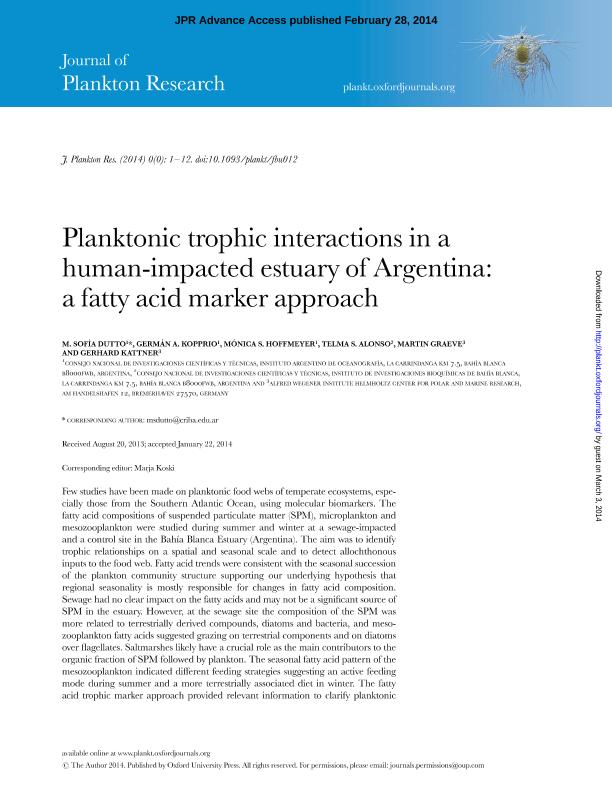Mostrar el registro sencillo del ítem
dc.contributor.author
Dutto, María Sofía

dc.contributor.author
Kopprio, Germán Adolfo

dc.contributor.author
Hoffmeyer, Monica Susana

dc.contributor.author
Alonso, Telma Susana

dc.contributor.author
Graeve, Martín
dc.contributor.author
Kattner, Gerhard
dc.date.available
2017-09-27T14:17:11Z
dc.date.issued
2014-03
dc.identifier.citation
Dutto, María Sofía; Kopprio, Germán Adolfo; Hoffmeyer, Monica Susana; Alonso, Telma Susana; Graeve, Martín; et al.; Planktonic trophic interactions in a human impacted estuary of Argentina: a fatty acid marker approach; Oxford University Press; Journal of Plankton Research; 36; 3; 3-2014; 776-787
dc.identifier.issn
0142-7873
dc.identifier.uri
http://hdl.handle.net/11336/25183
dc.description.abstract
Few studies have been made on planktonic food webs of temperate ecosystems, especially those from the Southern Atlantic Ocean, using molecular biomarkers. The fatty acid compositions of suspended particulate matter (SPM), microplankton and mesozooplankton were studied during summer and winter at a sewage-impacted and a control site in the Bahía Blanca Estuary (Argentina). The aim was to identify trophic relationships on a spatial and seasonal scale and to detect allochthonous inputs to the food web. Fatty acid trends were consistent with the seasonal succession of the plankton community structure supporting our underlying hypothesis that regional seasonality is mostly responsible for changes in fatty acid composition. Sewage had no clear impact on the fatty acids and may not be a significant source of SPM in the estuary. However, at the sewage site the composition of the SPM was more related to terrestrially derived compounds, diatoms and bacteria, and mesozooplankton fatty acids suggested grazing on terrestial components and on diatoms over flagellates. Saltmarshes likely have a crucial role as the main contributors to the organic fraction of SPM followed by plankton. The seasonal fatty acid pattern of the mesozooplankton indicated different feeding strategies suggesting an active feeding mode during summer and a more terrestrially associated diet in winter. The fatty acid trophic marker approach provided relevant information to clarify planktonic trophic interactions and to trace the origin of organic matter in this highly dynamic temperate coastal system.
dc.format
application/pdf
dc.language.iso
eng
dc.publisher
Oxford University Press

dc.rights
info:eu-repo/semantics/openAccess
dc.rights.uri
https://creativecommons.org/licenses/by-nc-sa/2.5/ar/
dc.subject
Predator-Prey Relationships
dc.subject
Molecular Biomarkers
dc.subject
Plankton
dc.subject
Sewage
dc.subject
Coastal Environment
dc.subject
South America
dc.subject.classification
Oceanografía, Hidrología, Recursos Hídricos

dc.subject.classification
Ciencias de la Tierra y relacionadas con el Medio Ambiente

dc.subject.classification
CIENCIAS NATURALES Y EXACTAS

dc.subject.classification
Bioquímica y Biología Molecular

dc.subject.classification
Ciencias Biológicas

dc.subject.classification
CIENCIAS NATURALES Y EXACTAS

dc.subject.classification
Otras Ciencias Químicas

dc.subject.classification
Ciencias Químicas

dc.subject.classification
CIENCIAS NATURALES Y EXACTAS

dc.title
Planktonic trophic interactions in a human impacted estuary of Argentina: a fatty acid marker approach
dc.type
info:eu-repo/semantics/article
dc.type
info:ar-repo/semantics/artículo
dc.type
info:eu-repo/semantics/publishedVersion
dc.date.updated
2017-08-08T14:37:29Z
dc.journal.volume
36
dc.journal.number
3
dc.journal.pagination
776-787
dc.journal.pais
Reino Unido

dc.journal.ciudad
Oxford
dc.description.fil
Fil: Dutto, María Sofía. Consejo Nacional de Investigaciones Científicas y Técnicas. Centro Científico Tecnológico Conicet - Bahía Blanca. Instituto Argentino de Oceanografía. Universidad Nacional del Sur. Instituto Argentino de Oceanografía; Argentina
dc.description.fil
Fil: Kopprio, Germán Adolfo. Consejo Nacional de Investigaciones Científicas y Técnicas. Centro Científico Tecnológico Conicet - Bahía Blanca. Instituto Argentino de Oceanografía. Universidad Nacional del Sur. Instituto Argentino de Oceanografía; Argentina
dc.description.fil
Fil: Hoffmeyer, Monica Susana. Consejo Nacional de Investigaciones Científicas y Técnicas. Centro Científico Tecnológico Conicet - Bahía Blanca. Instituto Argentino de Oceanografía. Universidad Nacional del Sur. Instituto Argentino de Oceanografía; Argentina
dc.description.fil
Fil: Alonso, Telma Susana. Consejo Nacional de Investigaciones Científicas y Técnicas. Centro Científico Tecnológico Conicet - Bahía Blanca. Instituto de Investigaciones Bioquímicas de Bahía Blanca. Universidad Nacional del Sur. Instituto de Investigaciones Bioquímicas de Bahía Blanca; Argentina
dc.description.fil
Fil: Graeve, Martín. Alfred Wegener Institute Helmholtz Center for Polar and Marine Research; Alemania
dc.description.fil
Fil: Kattner, Gerhard. Alfred Wegener Institute Helmholtz Center for Polar and Marine Research; Alemania
dc.journal.title
Journal of Plankton Research

dc.relation.alternativeid
info:eu-repo/semantics/altIdentifier/url/http://plankt.oxfordjournals.org/content/early/2014/02/27/plankt.fbu012
dc.relation.alternativeid
info:eu-repo/semantics/altIdentifier/doi/http://dx.doi.org/10.1093/plankt/fbu012
Archivos asociados
